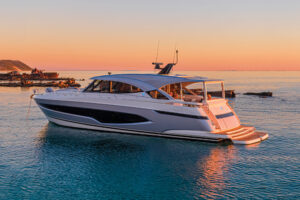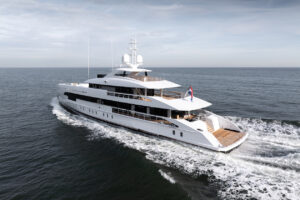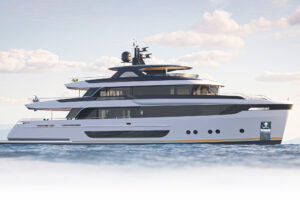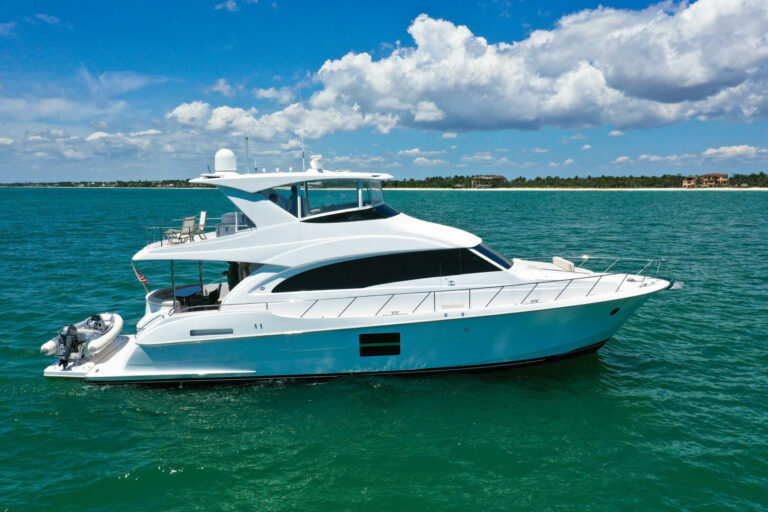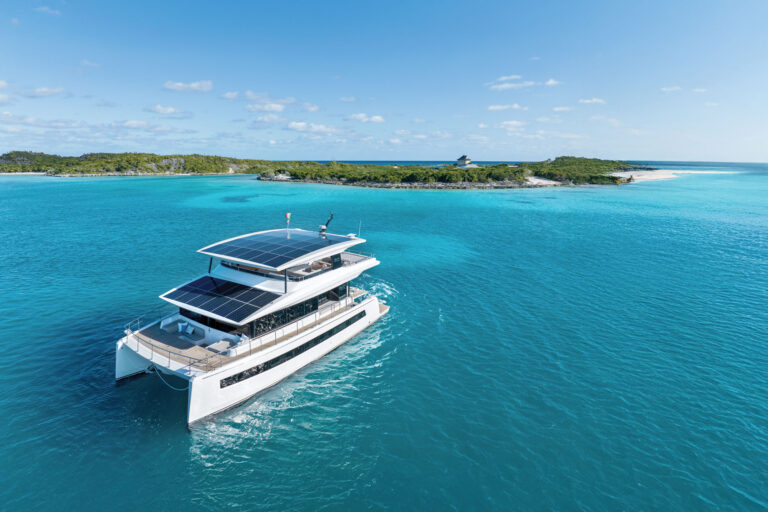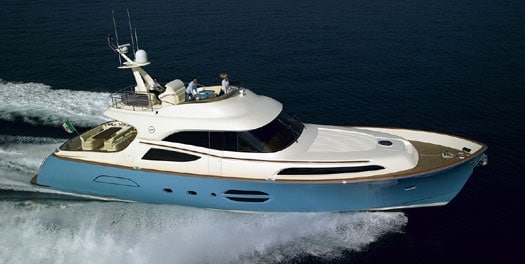
A lack of traditional stanchions and rails contributes to the clean deck form.
It was not a good day to be in Italy. There was a 24-hour general strike so most services had come to a standstill, and just to make life worse, it was pouring rain. Anyway, I was there to test a new boat; at least that was not affected by the strike. As I stepped on board the rain stopped and the sun came out. I am sure it was not coincidence, but from that point on, the world became a better place.
That’s why we go down to the sea in yachts, of course-to change our mood, refresh our outlook on life, charge up the batteries with new vistas and adventures. Yachts take us places, both physically and spiritually-which may go some way in explaining the current popularity of the lobster boat, even in Europe.
The lobster boat has been around for quite a few years. Very much an American product, it originated in the waters of New England, where lobsters were so plentiful they were regarded as a nuisance for many years. Yet here I was in Italy, not only testing a new lobster boat concept, but one that was claimed to be the largest lobster boat in the world. This was something of a surreal experience, and I wasn’t sure what to expect.
The various yards within the Ferretti Group in Italy build nearly every type of yacht, from the high-performance Pershings to the CRN superyachts. When Ferretti took over the Mochi yard, it had to find a new product, and seeing the success of the traditional lobster boat revival in America, the boatbuilder thought there was a niche for this type of boat in the rest of the world. This is what led to the introduction of the Mochi 51 last year, and this traditional design was well received on the market. So the next challenge was to extend this concept to a larger boat, a motoryacht based on the traditional lines, but with every modern facility on board.
No one had built a 74-foot lobster boat before, so this proved a challenge to Victory Design, the designers of the 51. Could the designers retain the same beautiful lines and traditional features of the original lobster boat while moving a big step up the size scale? In the Mochi 74 MaxiDolphin, Victory has certainly produced a very original design that will appeal to boat owners looking for something different. In fact, I think they have come up with a very viable alternative to the modern motoryacht.
Even on the Mochi 51, the design had moved away from tradition in many respects, yet it still retained the time-honored flavor. While the hull has the flared bow, the fine entry and the aft tumblehome we are familiar with, the superstructure follows more closely to the compound curves of modern design. It is only by retaining features like curved teak handrails and no outside rails that the traditional image is maintained. The designers have provided a serious inner handrail for safety on the foredeck, but the absence of outer rails means that the foredeck is a no-go area at sea.
One of the nice features of this boat is that you do not feel crowded in by the design. There seems to have been generous space given over to each feature and the designers have not tried to squeeze the last ounce of space in the interior at the expense of the external style. You see this in the cockpit, where there is space for rope bins alongside the mooring fittings and room for a table with two settees. This table converts into a sunbed, and there is also a bar unit to serve drinks here. The penalty for this generosity comes in a smaller saloon, but by making this an open-plan space, there is quite a lot fitted in without it feeling cramped.
Here the wide beam of this design allows the dining table to be at the side of the lounge area. This arrangement leaves room for the open galley and its breakfast bar alongside the helm, but the price you pay for this is the provision of only two seats that would be comfortable for use at sea. These are at the helm, which is offset to starboard. Both seats face an extensive and well-laid-out dash.
A three-screen nav layout makes a lot of sense, with the radar and chart on two of the screens and the monitoring and control of the boat systems on the third. Ferretti has developed its own system for this third screen, and this gives touch-screen control for the electrical, fuel and water systems on board as well as for the safety features. There is no sense of tradition here-the test boat was also equipped with a bowthruster and Ferretti’s gyro-controlled anti-rolling system, which was very effective. You cannot get much more up-to-date than that. Another break with tradition could be seen in the windshield, which comprises two deeply curved areas of glass that each cost close to $10,000-probably more expensive than the original lobster boats of Maine.
Down below there is the usual four-cabin layout with the master suite amidships, two twin-berth cabins and the VIP cabin in the bow. The master has a full-width bathroom at its aft end that separates it from both the narrow crew cabins and the engine compartment. The bathroom has a wash basin and head on each side, with the spa bath located between them-an interesting arrangement, but getting into the bath from either end is not an easy step.
Options in the layout mainly revolve around what you do with one of the two-berth cabins. In standard form this cabin has a lower bunk with a Pullman berth above it, but this space can also be specified as a study with or without the bathroom in the corner, or it can be a very spacious laundry room. Unless kids, with their big laundry requirements, feature in your yachting, it seems that the study option is going to be the one to go for. This area could also be the galley to free up space in the saloon, but I cannot imagine an owner wanting the galley outside his bedroom door.
The tender and a jet bike can be stowed in the generous garage leaving the swim platform and the flybridge uncluttered. The flybridge’s innovative layout places the control console well aft, just in front of the mast pedestal, with the leisure area forward. A logical arrangement, it allows the skipper not only to be part of the social scene but also to keep an eye on what is going on. Built into the mast base is a bar unit. The layout works well, getting reasonable wind protection from the forward screen and the dedicated deflector on the console.
In harbor, the looks of the Mochi 74 MaxiDolphin take some getting used to, but I think that is partly because of the unusual steely blue of the hull on the prototype. At sea, running at speed, it looks very workmanlike, very lobster boat with its bow in the air, and the proportions look just right. Below the waterline there is a conventional deep-V hull, which performs well in waves and gives a controlled and smooth ride.
With two 1,500 hp MTU diesels tucked away in the engine compartment, there is plenty of power for performance. The boat tops out at 33 knots, good progress by most standards. The engines are on a V-drive system, a layout that tends to raise noise levels in the accommodation, but this allows good space in the engine compartment even with the garage intruding.
This new approach to larger motoryachts seems to work. There was never a true lobster boat quite like this, but for those wanting a touch of tradition combined with modern performance this could be the boat to go for.
Contact: MarineMax, (888) 71-YACHT; www.marinemaxyachts.com.

